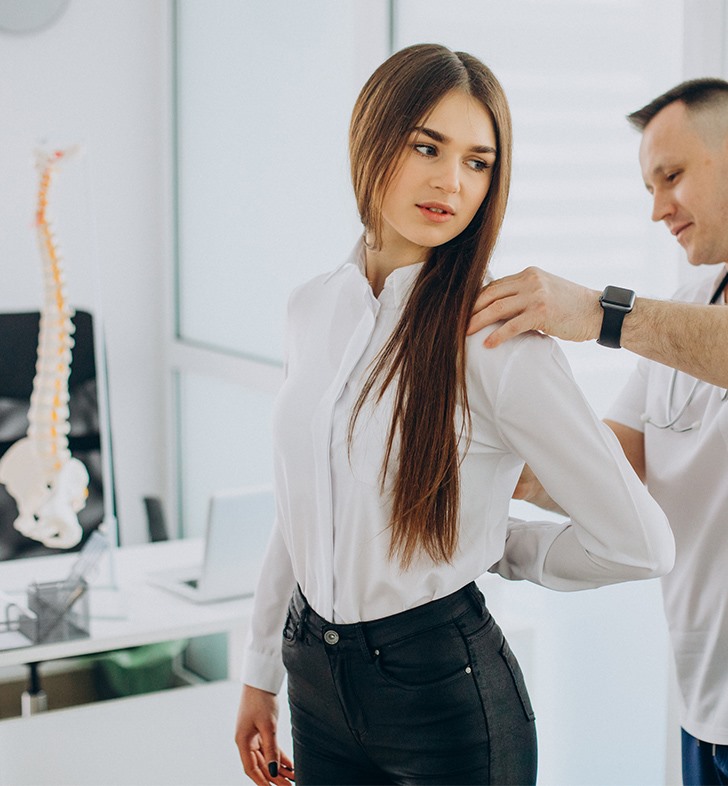
Adult Scoliosis
What is adult scoliosis? Scoliosis is an abnormal curvature of the spine (backbone). There is a natural, forward-and-backward curve to the spine. With scoliosis, the spine rotates and develops a side-to-side curve. Curves may be as mild as 10 degrees, or as severe as 100 degrees or more. Most cases of scoliosis are mild and don’t need treatment. In adults, the degree of the spinal curve may or may not determine treatment. Treatment is geared towards relieving symptoms, and not necessarily fixing the curve. The goal is always to decrease pain and improve function. Though scoliosis itself is painless, the normal age-related degeneration of the spine may lead to symptoms. These symptoms are treated the same whether there is scoliosis or not. Scoliosis only becomes a factor when surgery is being considered. Changes in the appearance of the body are also possible depending on the degree of the spinal curve. In general, most scoliosis in adolescents occurs in the thoracic or rib cage portion of the spine. In adults the main concern is typically in the lumbar or lower spine. This portion of the spine is most susceptible to the changes seen with aging or degeneration.
What causes adult scoliosis? The cause of adult scoliosis varies depending on the type of scoliosis. The most common form of adult scoliosis is degenerative (spine curves as you age). Adult scoliosis may be a case of pediatric scoliosis that was undiscovered until adulthood. In some cases, adolescent scoliosis may develop symptoms with aging and require treatment. Idiopathic (coming from an unknown cause) scoliosis is usually discovered during growth in childhood or adolescence. When it begins or is found after puberty, it is called adult idiopathic scoliosis because the curve is discovered after complete skeletal growth.
What are the symptoms of adult scoliosis? Most cases of adult scoliosis don’t cause symptoms, though pain may develop. Back pain occurs for many reasons including arthritis, inability to stand upright, and/or due to weakness of the core musculature and loss of conditioning. Leg pain/numbness/weakness may develop if there is pressure on the nerves in the lumbar spine. In some cases, changes in the body may include: Height loss Uneven alignment of the pelvis and hips
How is adult scoliosis diagnosed?
Before your doctor can suggest a
treatment plan, if adult scoliosis is suspected, he/she will need to take a
history. This may include questions about:
- Family history
- Date when you first noticed change
in your spine
- Curve progression (determined from
earlier X-rays, if available)
- Presence and location of pain, if
any
- Any bowel, bladder, or motor
dysfunction, which may be signs of more serious nerve damage or pressure caused
by scoliosis
- In a physical exam your doctor will
examine your back to check the shape of your spine and see how you move around.
Your nerves may also be tested through reflex, sensation and muscle-strength
checks.
- If needed, your doctor may order
X-rays. X-rays taken from the front and side will show a full picture of your
spine. Your doctor can then determine if you have scoliosis and if so, to what
degree.
How is adult scoliosis treated?
Conservative treatment
The majority of cases of adult
scoliosis can be managed non-operatively through regular observation by a
doctor, over-the-counter pain medications, and core-strengthening exercises to
strengthen your abdomen and back and to improve flexibility. If you smoke, it’s
important that you quit. Smoking has been shown to speed up the degenerative
process.
In most cases, your doctor will
recommend some forms of physical therapy, to both maintain strength and relieve
pain. These may include:
- Working to improve posture
- Doing low-impact exercises, such as swimming
- Daily stretching
- Staying active
- If pain is not relieved by oral
medications or physical therapy, your doctor may recommend epidural (given
around the spinal cord) or nerve block injections for more effective relief.
- Surgical treatment
Surgery is necessary in some cases
of adult scoliosis. This treatment is the last option because of the risks of
complications from spinal surgery. Surgery may be suggested for the following
reasons:
- Pain. Surgery may be needed if back and leg pain
from the scoliosis becomes severe and ongoing, and doesn’t respond to
conservative treatment.
- Spinal imbalance. Whether the spine remains
balanced is important in assessing the scoliosis’ progression and the need for
surgery. When we stand, the head should be balanced over the center of the pelvis
when looking from the front, and over the hip joints when looking from the
side. If the curve progresses to the point that this is no longer possible,
patients will tend to progress over time and have more pain and disability.
- Surgery is needed to improve quality of life.
Although surgery is not recommended solely to improve appearance, some people
find the symptoms of their spinal deformity unbearable. Their spinal imbalance,
too, affects basic function and overall quality of life. Surgery is the only
option in these cases. In younger adults the cosmetic deformity may be a major
factor in the decision to have surgery but in older adults this is not usually
the case. There are a variety of spinal surgical options, depending on each
case. Generally, surgical procedures are designed to stabilize the spine,
restore balance, and relieve pressure on nerves. Spine stabilization surgery
fuses the bones of the spine together using bone grafts and then metallic
implants to hold the spine in place.
Advances in surgical techniques and
computer-assisted navigation systems make less invasive approaches possible,
and recovery time quicker.